
Infographic: Jihane Ben Aissa-Chartier.

Reflections on the Women Aki Takai by Kate Sylvester.
In this article, I write about my personal perspective as a seminar participant, competitor, and spectator of the 7 dan competition at the Women Aki Taikai, 2023. A full report on the Women Aki Taikai will feature in the upcoming issue of Fine Ladies Kendo Worldwide Magazine.
The first Women Aki Taikai took place in Nanterre, France, the last weekend in September, 2023. It was a significant event for several reasons. Firstly, it illustrated the progress of women’s kendo through a seminar led by seventeen 7 dan women sensei, which was participated in by 150 female participants of 26 nationalities, from ages of 13 to 68-years-of-age. Most notably, it was also the first time in European history for a 7 dan women individual competition to be held.
Another remarkable feature of the event was that the seminar and competition grouped participants by grade. In total there were four groups for the seminar; kyu, 1-2 dan, 3 dan, 4 dan, 5-6 dan, and each group was led by 3-4 women 7 dan sensei. The competition was similarly divided, but with more categories and by each grade level; kyu, 1 dan, 2 dan, 3, dan, 4 dan, 5 dan, 6 dan, and 7 dan.
There was a broad representation of participants; some that were fairly new to kendo, kenshi with 20+ years, others were top class national team members. France and Poland had a strong contingent of past, present, future national team members. There was also supposed to be a fighting fit representation of Italian women, but unfortunately due to strikes, Mirial Lilvolsi sensei and others were unable to attend.
Despite the breadth of kendo level and experience in the arena, it was an atmosphere of support, sociability and synergy. The space felt cooperative, non-judgemental, respectful, and encouraging. As a seminar participant and a researcher of women’s kendo, I was curious to see how this group of 7 dan women sensei of different backgrounds, experiences, and perspectives would work together to manage a seminar and competition format that catered for each grade level. It was noticeable that the sensei were working in collaboration, and as individuals they demonstrated a sincere intent of sharing knowledge and inspiring kendo development and confidence in the participants. I sensed that the sensei were kendo intelligent and perceptive through the feedback I received on my kendo. The advice resonated with my physical and spiritual kendo goals.
It was the first seminar and competition I had attended for several years, and I felt a combination of nervousness and excitement, not knowing what to expect as a seminar participant, or how I would perform in the 6 dan competition category. I felt a sense of pressure to show decent kendo as a 6 dan, a national team coach, and as a researcher who has been quite vocal about gender issues in kendo. I am also fairly new to the European kendo scene and I was enthusiastic about connecting with women in Europe. I felt moved by the number of women who approached me and thanked me for the work I am publishing on my blog site, Kate Sylvester Perspectives. Some expressed that the articles empowered them, recognised their under-appreciated achievements, or provided a perspective on gender issues that inspired news ways of thinking about kendo.
Over the weekend, a number of women also shared their reflections on the event. Many women newer to kendo expressed that, for once, they did not feel like the minority and that it was enjoyable to train with many women from other countries. Some commented that it was rewarding to receive teachings from women sensei with various experiences, knowledges, and “feeling.” Many also appreciated the attention they received during the seminar as there were 3 or 4 sensei teaching each group. For others, they expressed that the event provided a space to share about happenings in their lives in and outside of kendo and receive support and encouragement. Many women shared the sentiment of “finally” and that they were grateful to be a part of this historical event.
From speaking with women over the weekend, it was apparent that the event was overall a positive experience. There was certainly appreciation felt for the male volunteers (video, tables, catering, transport etc) who contributed their time in support of the event. However, there was some criticism about the presence of male shimpan for the 7 dan women’s competition and their participation in the keiko at the end of the day. At first, I felt a little bewildered by this organisational aspect, especially considering that some of the invited shimpan were 6 dan and there were 6 dan women seminar participants. However, after a discussion with the head organiser Blanchard sensei, and some reflection, it made sense why, on this occasion, the shimpan were men.
The invited shimpan were European Kendo Championship (EKC) level shimpan, and for the 7 dan women competition, it was necessary to have the most experienced shimpan available, other than the 7 dan women competing. It is also important to consider that it is kendo etiquette to invite high grades who have contributed their time to participate in keiko after such an event. It would have been disrespectful, and in opposition to the objective of the event, to not invite the shimpan and CNKDR (French National Kendo Committee) representatives that have expressed their support of the event through their attendance and the federation’s sponsorship. For future editions, there is a plan to have women referee the event, but this will depend on availability of non-competing 7 dan women and the experience of 6 dan women participants. It is therefore important for 6 dan women to pursue EKC referee opportunities.
Day 1 (Seminar and 7 dan Competition)
The CNKDR and the EKF (European Kendo Federation) sponsored event was kicked off with warm welcoming words from Sophie Kong, head of the women’s commission of the CNKDR and head organiser Aurélia Blanchard sensei. Some inspiring comments from EKF representative Donatella Castelli sensei followed.
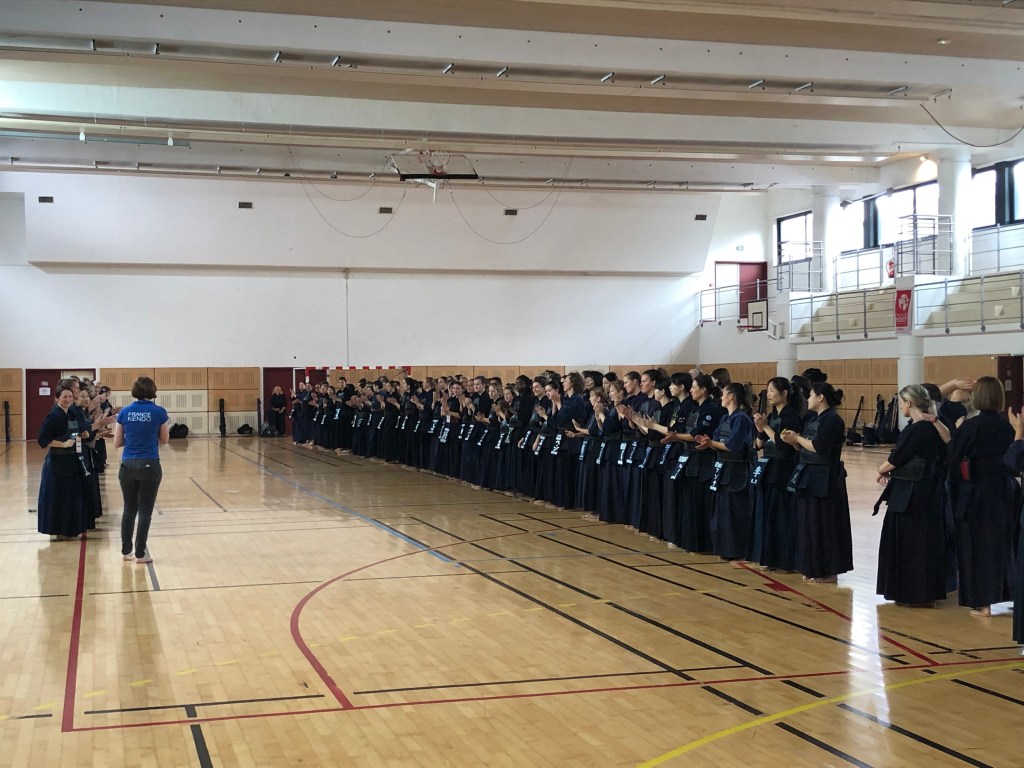
Photo: Opening ceremony
After an energising warmup by Dance Yokoo sensei, the participants were then divided into 5 groups based on grade level kyu, 1-2 dan, 3 dan, 4 dan, 5-6 dan, and each group was led by 3-4 women 7 dan sensei.

Photo: 4 dan seminar group

Photo: 1-2 dan seminar group
I participated in the 5-6 dan group that consisted of approximately 35 women. The 5-6 dan seminar was divided into 4 sessions, and 3 sensei assigned to the group alternated leading a specific topic. Kazuyo Matsuda sensei led the first session, which broke down the mechanics of cutting action. Drawing from Setsuko Kobayashi sensei’s teaching, Matsuda sensei introduced exercises that would improve use of the shoulders when cutting with the special focus on the left arm and shoulder. It was interesting to do exercises reversing the kamae, with the right hand holding the bottom of the shinai.

Photo: Matsuda sensei instructing
Thereafter, Katja Fleury sensei taught the specifics of jodan, as a player and as an opponent of jodan. It was valuable to learn how to coordinate your body movement and generate strength in casting the shinai as a jodan player. It was also informative to experience how it felt to face opponents as a jodan player and it allowed me to consider how and where jodan feel pressure from chudan players.
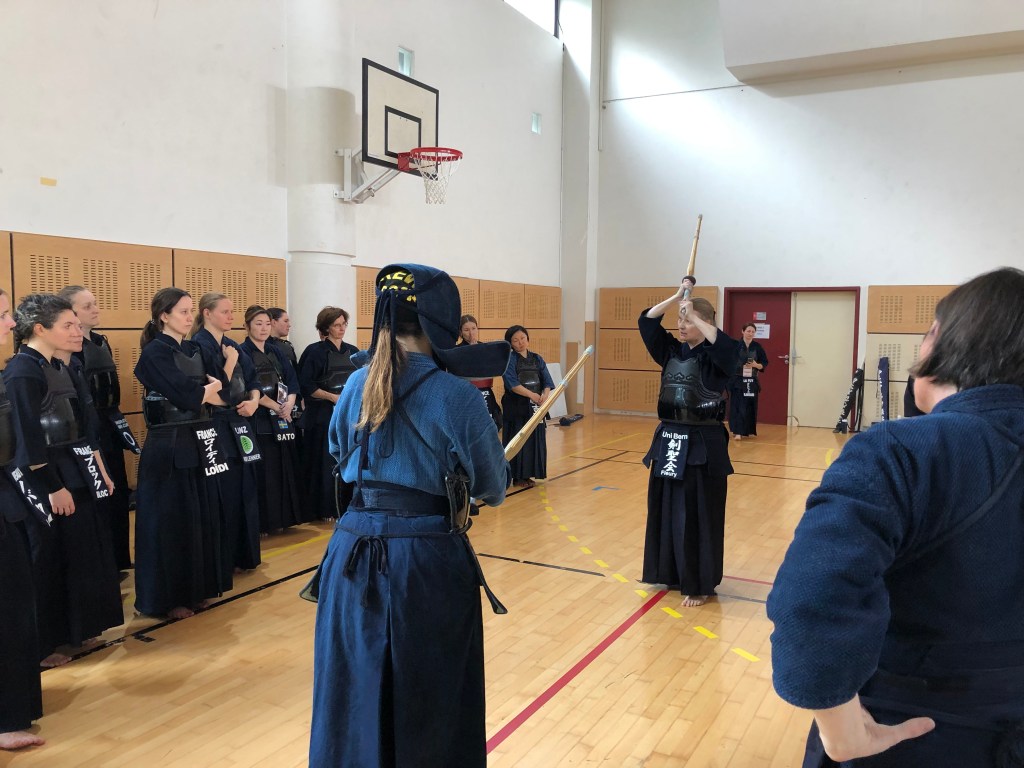
Photo: Fleury sensei instructing
In the next session, Matsuda sensei focused on kodachi kata 1-3. This was helpful as higher-graded kenshi rarely have the opportunity to work on the specific movements of kodachi kata. I found it particularly useful to work on parrying the tachi and practicing swift footwork.
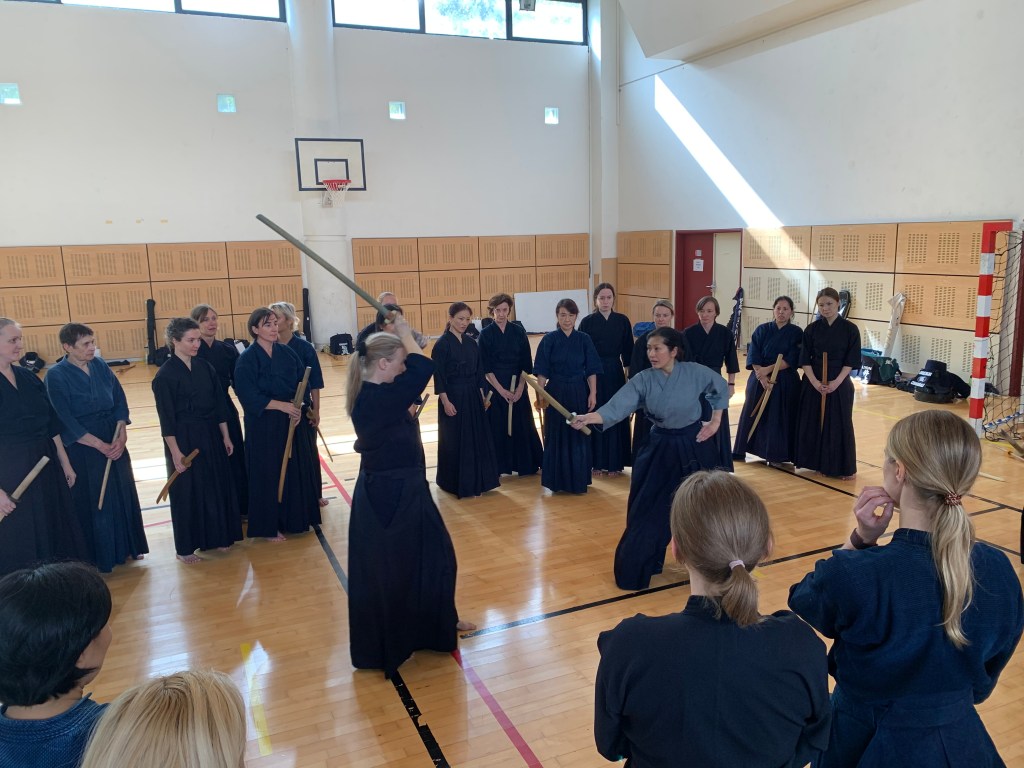
Photo: Matsuda sensei instructing
Admittedly, when it came to the next session, I felt quite uncoordinated after using my body in different ways in the previous sessions. However, this consciousness reminded me of what it may feel like being a beginner in kendo and it also opened new pathways between my mind and body.
In the last session of the seminar, Kumi Sato sensei imparted some useful tips on attempting high grade exams and how to give feedback to lower graded kenshi during keiko. During this session, the sensei also shared their 7 dan related experiences and sense of responsibility on being 7 dan. This discussion was valuable, and given the number of highly active 5-6 dan women kenshi in the room, it helped us to think about the current position and the next stage in our kendo leadership roles.

Photo: Sato sensei instructing
Overall, the 5-6 dan seminar session was stimulating and it inspired self-reflection. The sensei’s passion for kendo was expressed through their knowledge shared and teaching style. This was probably a reason why the seminar time passed so quickly and it seemed that the participants were enthusiastic to learn more from the sensei. I predict that the seminar will be extended at the next Women Aki Taikai.
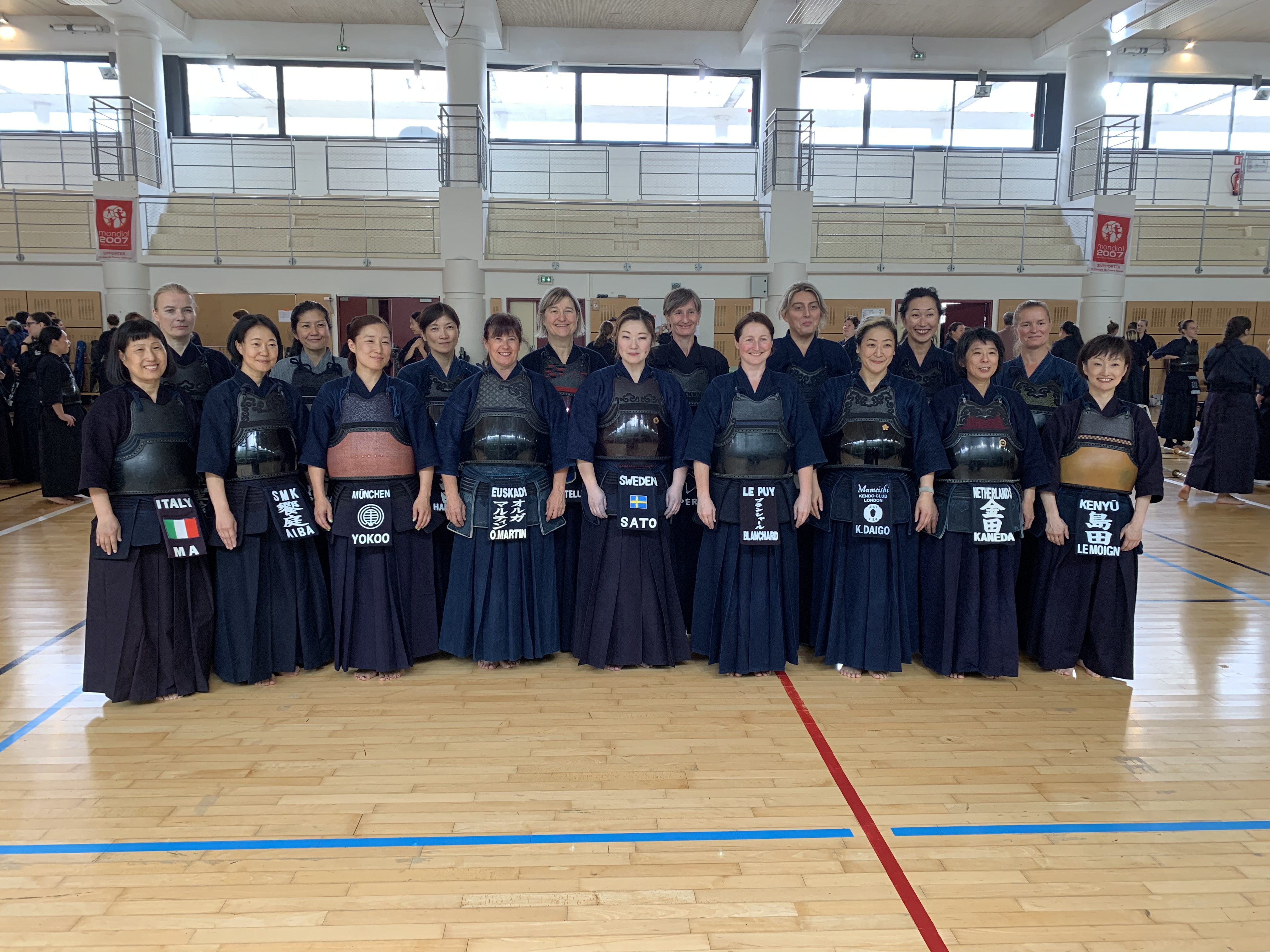
Photo: The 7 dan women sensei
The 7 Dan Competition
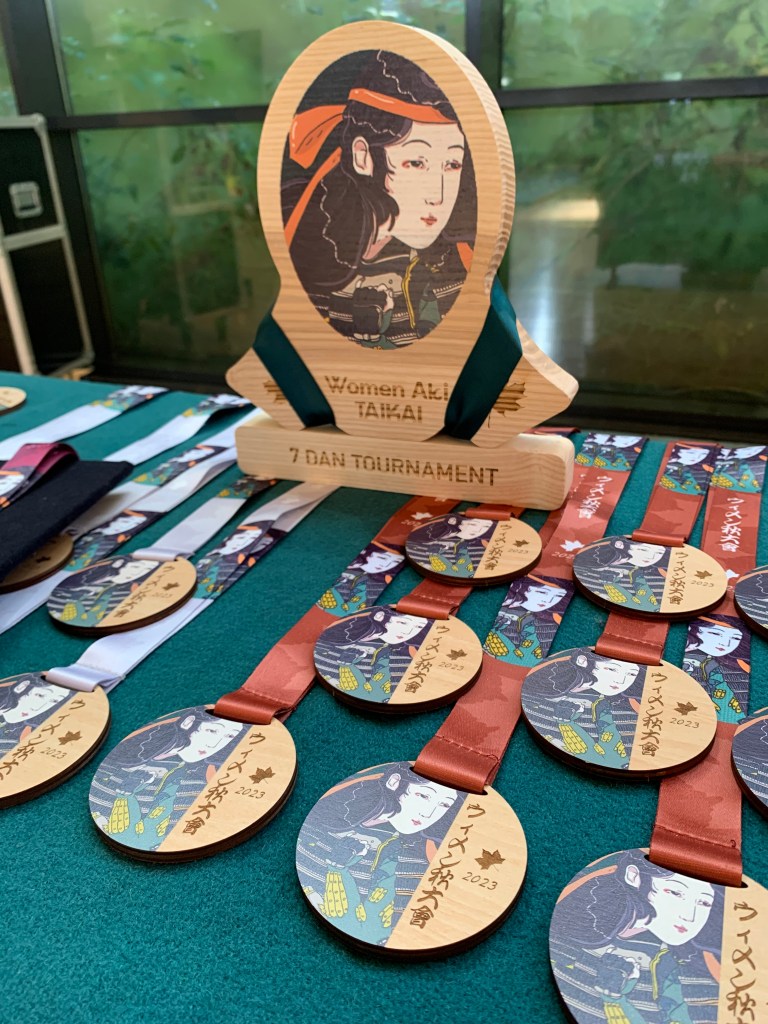
Photo: 7 dan trophy and other medals
The afternoon was devoted to the 7 dan women’s individual tournament. The first occasion in Europe, and first individual 7 dan women’s competition in the world. Although there are no individual tournaments dedicated to 7 dan women in Japan, there are more opportunities for 7 dan women to compete against 7 dan women, of similar age, in competitions such as the All-Japan Interprefecture Ladies Kendo Championship (Todōfuken) and All-Japan East VS West Japan Kendo Championship (Tōzai-Taikō) and less formal competitions such as the Otsūhai and Mainichi Ladies Tournaments.

Photo: Opening of 7 dan competition
The event was significant, which may have presented novel pressures. Not only was it the first shiai that some of the sensei had participated in a period of time, it was probably the first opportunity that the sensei had to compete with other 7 dan women in a public arena. The event was uploaded on YouTube and watched by an inhouse crowd of approximately 140 people. In addition to the controversy that had surrounded the coming about of the event. Imagining myself in that position, I may have felt some additional pressure with the expectation of performing 7 dan kendo in a formalised competition setting, which was refereed by people who had previously made decisions on 7 dan women’s inclusion in the Open de France. However, it did not seem to faze the competitors.
What I most respected and admired about the women 7 dan sensei is that probably, not all had the personal ambition to compete in the taikai. Perhaps some agreed to compete in support of the taikai and the symbolic importance of the event. From my perspective, participation by all the sensei made a strong statement, it demonstrated contribution to women’s kendo development as a selfless gesture that is worthy of the highest respect. It is quite likely that the 7 dan men who competed in the Open de France have not had to face the expectations and performance pressures mentioned above.
All seminar participants watched the 7 dan competition with focused enthusiasm and interest.

Photo: 7 dan competition
Observing the sensei preparing for their matches, it was apparent that they had prepared for the event and that they were supporting each other’s performances.

Photo: 7 dan competition

Photo: 7 dan competition
Each sensei put forth commendable competitive performances and beautiful examples of high-level kendo. The matches demonstrated 7 dan level kendo in terms of presence, connection, rationality, and commitment. In the opening match between Olga Martin sensei and Misako Aiba sensei, the connection between the sensei was palpable. Both were searching for openings and executing attacks with measured kendo wisdom. Taking advantage of an opening with precise timing, Martin sensei eventually won the match with an ippon men.
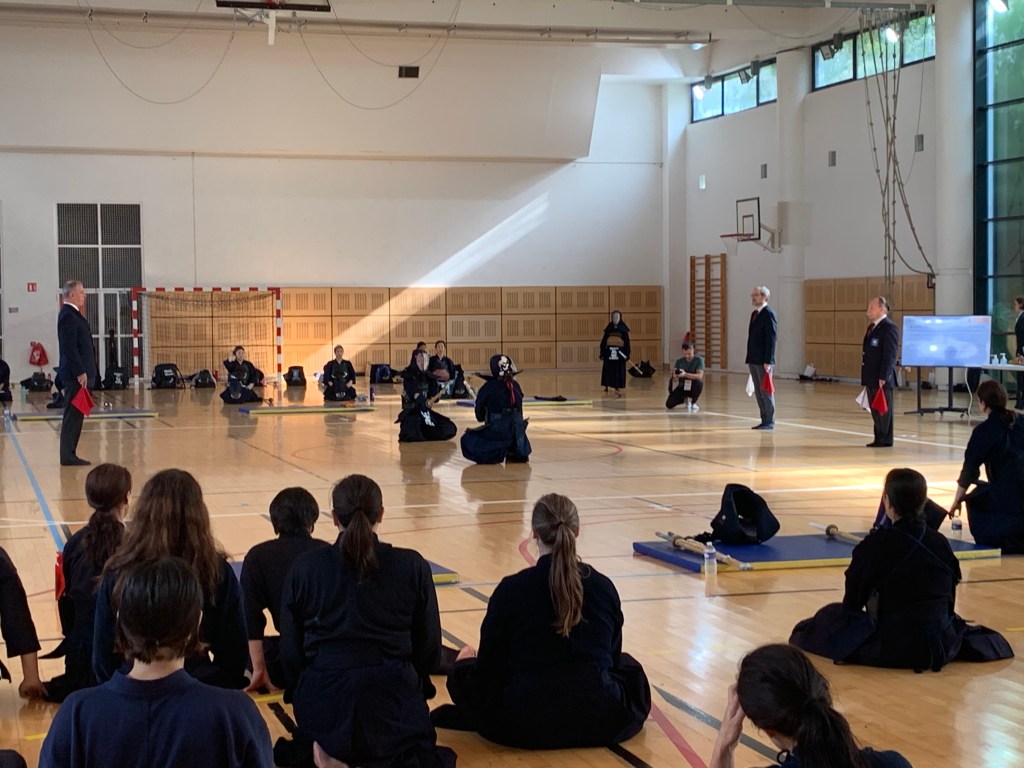
Photo: Opening match
The final between Jana Ziegelheimova sensei and Dance Yokoo sensei was exhilarating. Two styles connected by spirit and shinai, both equally determined to be victorious. After an intense period of pressing for each other’s openings and exchanging astute attacks, Yokoo sensei scored a clean ippon kote that was followed by a hiki-men some moments later. It was an awe-inspiring final.

Photo: Final match
Results
D. Yokoo (gold)
J. Ziegelheimova (silver)
S. Péré & K. Daigo (bronze)
A. Blanchard (fighting spirit)

Photo: 7 dan competition result
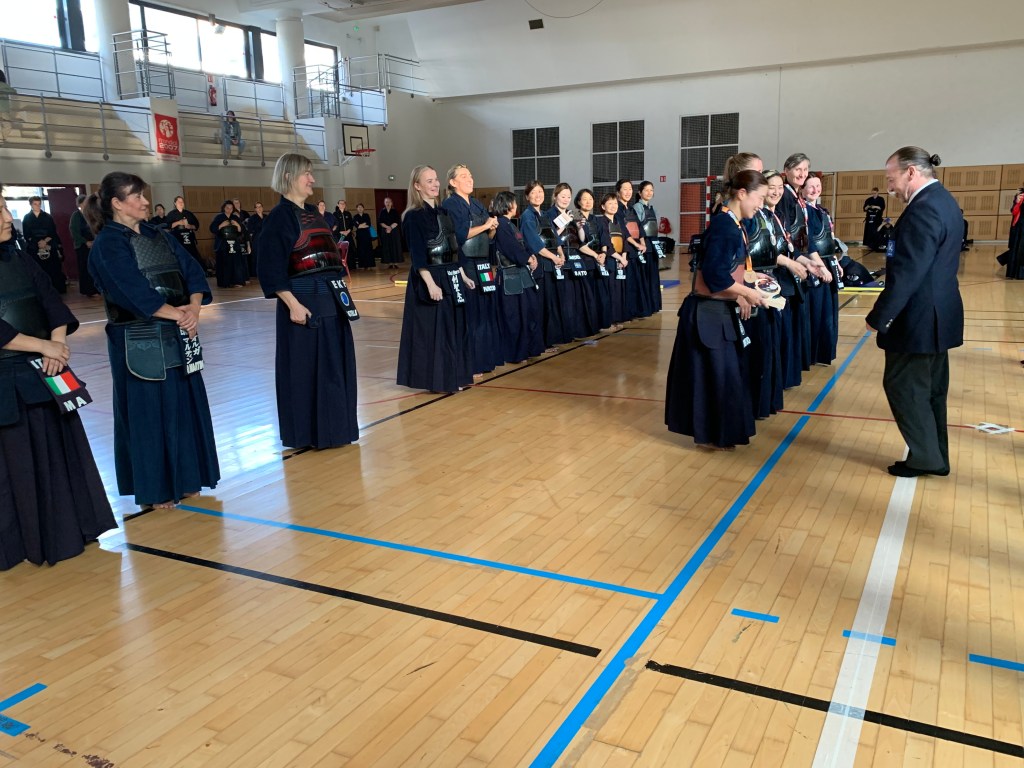
Photo: Awards ceremony for 7 dan competition
Watch Women Aki Taikai 7 Dan Competition
Day 2 (Kyu and Dan Competition)
The second day of the event was dedicated to competition. Each competition was divided by kyu, 1 dan, 2 dan, 3, dan, 4 dan, 5 dan, and 6 dan. The taikai was refereed by 7 dan women sensei. All finals were held on the centre court after the pool and tournament section for each grade had concluded. This format was time efficient, and also promoted the final for each grade category to be prestigious and to be watched by all seminar participants.
Results
Kyu
A. Deishmann (gold)
I. Petitmangin (silver)
A. Pecoste & J. Ziegelheimova (bronze)
L. Facchin (fighting spirit)
1 dan
J. Bouaita (gold)
A. Sucher (silver)
H. Ando & M. Racle (bronze)
N. Leung (fighting spirit)
2 dan
K. Hirai (gold)
C. Allouche-Dufour (silver)
M. Ishikawa & M. Fisher (bronze)
I. Gyamfi (fighting spirit)
3 dan
K. Babinska (gold)
M. Avignon (silver)
I. Lazarovska & L.M. Tang (bronze)
A. Robin (fighting spirit)
4 dan
K. Moutarde (gold)
A. Wierzbowska (silver)
R. Bigex & M. H. Nguyen (bronze)
L. Ruvoen (fighting spirit)
5 dan
A. Yearwood (gold)
I. Loidi (silver)
M. Hoflenher & J. Labak (bronze)
A. Orizio (fighting spirit)
6 dan
L. Van Laecken (gold)
A. Dessireix (silver)
D. Kimura & A. Nakabayashi (bronze)
A. Gonzalez (fighting spirit)
Personally, the opportunity to participate in a 6 dan competition enticed me to step into the shiaijo again as a competitor. Prior to this event, as a 6 dan and national team coach, I did not have the desire to compete in open grade categories. A valuable aspect of this event was that it provided a goal and a new motivation to improve my kendo through the opportunity to compete amongst other women who are at similar points in their kendo journeys.
Some of the other 6 dan women competitors, who were mostly previous or present national team members, also mentioned that as competitors, the Women Aki Taikai shiai experience was different and they felt pressure to demonstrate 6 dan kendo whilst competing to win. Personally, I viewed the opportunity as a test to see where I was at in my kendo and how I managed the pressure of competing again. It brought back a lot of memories from my previous competitive participation in the World Kendo Championships (WKC). I had always enjoyed the long-term build up to the WKC and loved the electrifying experience of shiai, but I had never particularly enjoyed the moments before stepping onto the court.
Before my first bout at the Women Aki Taikai, I again felt a rush of all those pre-shiai emotions. The experience was a good reminder of what kendo athletes experience before competition. As a national team coach this understanding is important. In the process of feeling intense emotions and trying to make sense of them at this other stage in my kendo journey, I focused on the sensations in my body, particularly my heart. I felt the need to transform the emotions and enjoy the pre-competition experience. I thought about how significant the event was and how much I appreciated this opportunity to compete again. The notion of “love” came to my mind. I connected the powerful feeling in my chest to the feeling of love that I had felt for my daughter when she had become sad that I was leaving to travel to the event. I managed to convert my pre-competition pressures into a very potent sensation that helped me to approach my shiai with a positive mindset of “love.” I relished the opportunity to once again enjoy connecting with myself and others through the experience of competition. As such, it was an empowering and rewarding learning experience.
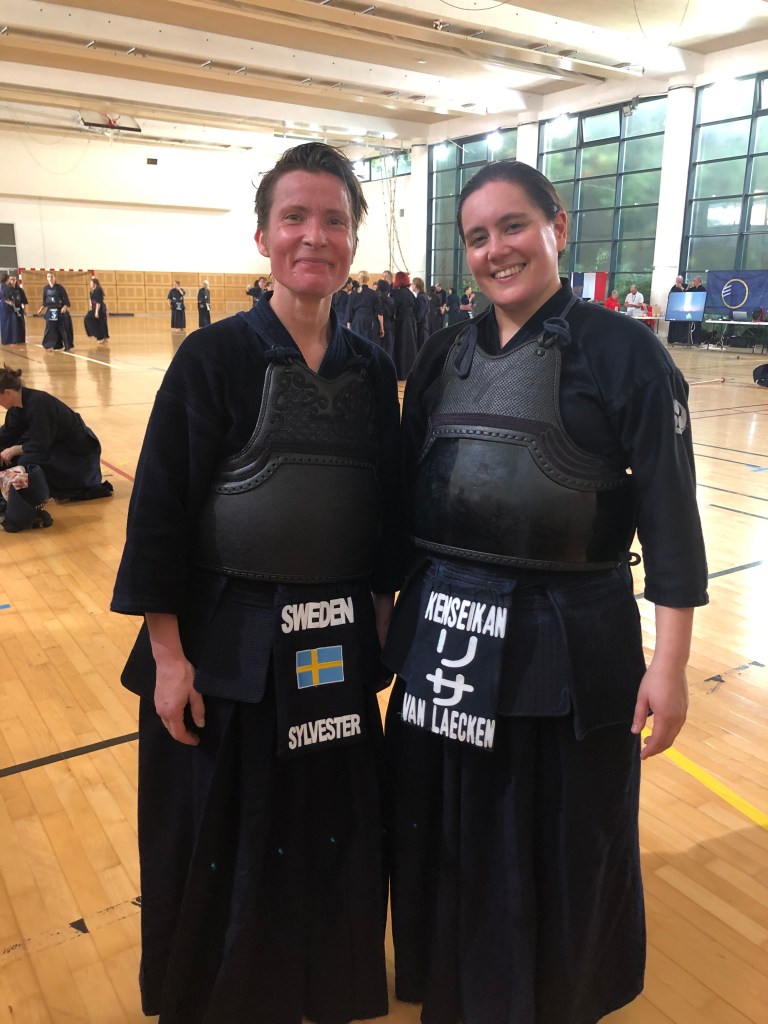
Photo: Author and 6 dan champion Lisa Van Laecken
Closing Ceremony
At the closing ceremony, it was announced that a women’s 7 dan category would be included at the Open de France. This was applauded. Blanchard sensei concluded her tremendous work over the weekend by acknowledging all of those that had contributed to the event, making a special mention of Jihane Chartier, Candice Allouche-Dufour and Alexiane René.
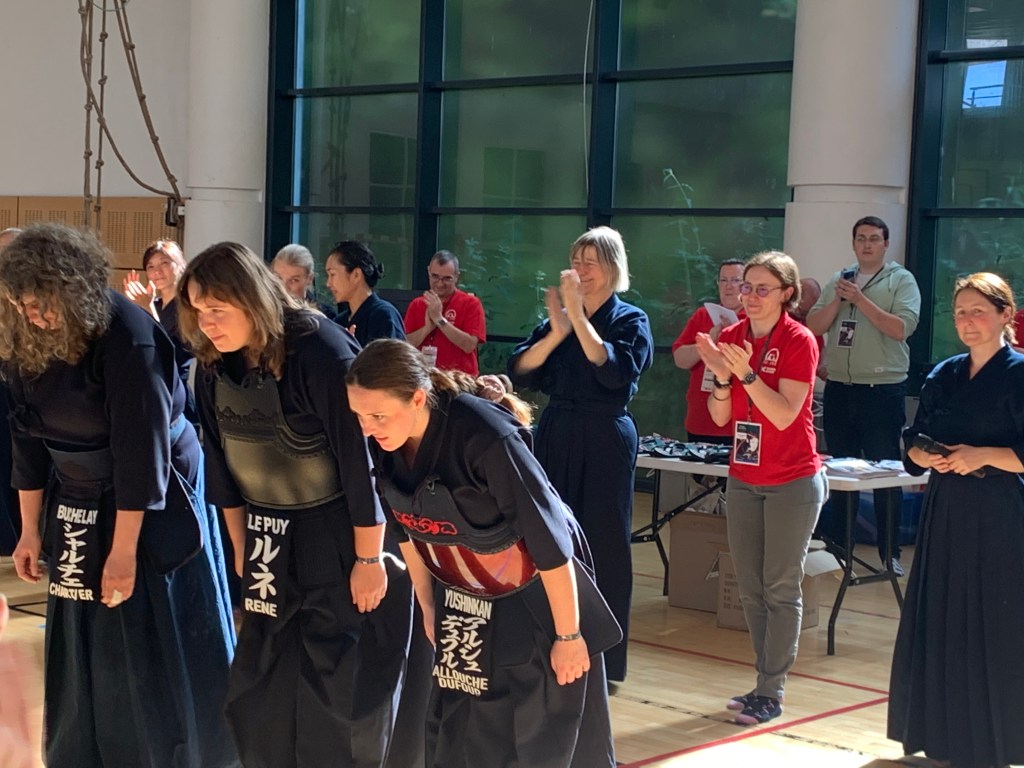
Photo: J. Chartier, C. Allouche-Dufour, and A. René
Matsuda sensei, CEO of Fine Ladies Kendo Worldwide Magazine, also spoke about the magazine’s important work that connects women’s kendo in Japan to the world. Castelli sensei’s final words encouraged us to work together to develop women’s kendo. I was also invited to speak at the end as I had written an article about the event. At that point, I felt quite emotional, and this was heard in my voice. I had gathered many impressions over the weekend and was particularly heartened by the respect, friendship, and mutuality I had observed. Most notably, the event marked change. I felt that the event complimented the aim of my work which is to improve the status of women in kendo. Through raising women’s status in kendo, I believe that gender-based issues women can encounter in kendo (harassment, discrimination, diminishment of achievement and ability) will abate. If I had been more composed when I spoke, I would have acknowledged the courage of Johanna Nowak in raising her voice about the Open de France. I also would have encouraged women to speak out and seek support for harassment, discrimination, and the diminishment of achievement and ability women experience, so that these are no longer considered “cultural norms” of kendo.

Photo: Author with Johanna and Amandine Nowak
As the event concluded, it was a special moment observing the sensei congratulating and hugging each other. The shared sense of accomplishment that the sensei demonstrated was heartwarming. The friendship and respect that the sensei collectively expressed was uplifting and inspired hope for the future of women’s kendo.

Photo: Closing ceremony
Concluding Remarks
It is common knowledge that the catalyst of the Women Aki Taikai was the ongoing exclusion of women from the 7 dan category at the Open de France. Some say that the reaction to this exclusion, the Women Aki Taikai, was unnecessary, arguing that there has always been a space for a women’s seminar and that there were simply not enough 7 dan women in Europe to create a category in the Open de France, 2023. In fact, there were enough 7 dan women and there was a demand for 7 dan women to have their own category at the 2023 Open de France. It is quite likely that previously, some women sensei have not felt it necessary to hold women-only events, as many women are accustomed to and enjoy training, teaching, and competing in non-segregated spaces. However, currently, women only events are important as they provide a much needed, supplementary way for women to develop skill, status, and connect to a network of community within a culture that has historically preferenced men and male values. The symbolic need for women-only events has never been as important as it is now. Women’s kendo in Japan is growing exponentially and it is becoming more obvious that the lag in global women’s kendo is due to an issue connected to women’s lower status in kendo. It is no longer commonsensical for sexism in kendo to be overlooked, accepted, or simply justified as “tradition.”
Many federations and dojos may feel assured that their practices do not overtly discriminate against, and disempower women. This viewpoint needs to be reversed. It is important for federation and dojo leaders to reflect on new and better ways for kendo, at the local level, to be more inclusive, provide more opportunities, and alternative ways to support women, or try different approaches to teaching, rather than insisting that “one map fits all” approach in a cultural sphere that centres on male; histories, bodies, and values.
A powerful observation of the Women Aki Taikai is that it appeared that the women sensei respected eachother’s differences, whilst supporting and encouraging eachother. It did not seem that there was tension or power struggles between the sensei. This observation challenged how the patriarchal sphere of kendo has set a perimeter that only allows women to compete for power and status amongst one another. This can provoke women to (consciously or unconsciously) push down other women to access the restricted power made available to women. The kendo path that provides a way towards self-actualisation and empowerment needs women to draw out the best in each other to reliably raise their own level of kendo with self-confidence. Improving women’s status in kendo requires strategic interdependency between women.
I anticipate that a need for women to “carve out their own space” and “push themselves into spaces” will continue due to the “tradition” of male leadership and values in kendo. Women’s events, networks, and courageous efforts are critically important now, but let’s hope in the future they will become less necessary as women’s status, membership, skill, confidence, and social connections in kendo spaces continues to grow. Together, with collaboration, support, and courage, a forward momentum will gain wind behind our efforts to normalise a new culture; one that is inclusive, safe, and empowering for all participants.
Disclosure statement
The articles published on this website present the owner of this blog website’s perspective, based on personal experiences, unless stated otherwise. They do not represent those of people, institutions or organisations that the owner may or may not be affiliated with in a personal or professional capacity unless explicitly stated. All content in these articles are for informational purposes only. People’s perspectives that may appear as information in these articles do not reflect the perspective of the owner or other people’s perspectives. Any views or opinions are not intended to malign any religion, ethnic group, club, organisation, company or individual. The owner of this blog makes no representations as to the accuracy or completeness on this site or found by following a link on this site. The owner will not be liable for any errors or omissions in this information nor for the availability of this information. The owner will not be liable for any loses, injuries or damages from the display or use of this website.
2 responses to “‘Reflections on the Women Aki Takai’ by Kate Sylvester.”
What a wonderful event! I’m very sorry to have missed it. I live in Germany and being the only female kendoka in my Dojo, I just missed the announcement. That also calls for the organization of a better online network that has the potential to reach every female kendoka worldwide, don’t you think?
LikeLiked by 1 person
Very nice 🙂
We are for Nepal kendo 🇳🇵☺️
LikeLiked by 1 person